3D Forward Simulation of Borehole-Surface Transient Electromagnetic Based on Unstructured Finite Element Method
Abstract
1. Introduction
2. Basic Theory
2.1. Time-Domain Diffusion Equation
2.2. Unstructured Finite Element Method
3. Algorithm Verification
4. 3D Borehole-Surface Model with Anomalous Body
4.1. Deployment Arrangements of Varied Survey Grids
4.2. Single High-Resistance and Low-Resistance Anomalous Body
4.2.1. Low-Resistivity Anomaly Body Model
4.2.2. High-Resistivity Anomaly Body Model
4.3. High- and Low-Resistivity Combined Anomaly Body Model
5. Comprehensive Practical Application
5.1. Synthetic Model with Topography
5.2. Realistic Mineral Deposit Model
6. Conclusions
- (1)
- In borehole-to-surface electromagnetic methods, deploying radial measurement grids is optimal for analytical processing of results. When field conditions preclude such deployment, conventional vertical measurement grids may alternatively be deployed, with subsequent computation of the radial electric field.
- (2)
- In the early stage, the response shape of the borehole-to-surface transient electromagnetic field is approximately symmetrical with respect to the well, and the signs of the electric field responses on both sides of the well are opposite. With the passage of time, the electric field response gradually weakens.
- (3)
- The borehole-to-surface transient electromagnetic field possesses a good ability to identify a single low-resistivity anomaly underground but cannot accurately reflect the existence of a single high-resistivity anomaly. For high- and low-resistivity anomalies at different positions, the same rule is followed. When conducting actual mineral exploration in complex and undulating terrains, the borehole-to-surface electromagnetic method can still effectively identify underground low-resistance ore bodies.
Author Contributions
Funding
Data Availability Statement
Acknowledgments
Conflicts of Interest
References
- Li, T.; Wang, J.; Zhu, K. Research on the exploration depth of the borehole-surface electromagnetic field. Prog. Geophys. 2013, 28, 373–379. [Google Scholar] [CrossRef]
- Zeng, Z.; Zhang, Q.; Wen, B. Progress in geophysical prospecting of Russia. Prog. Explor. Geophys. 2004, 27, 308–311. [Google Scholar]
- Xu, J.; Hu, W.; Li, P. Electromagnetic fields of a vertical electric dipole in a two-layered conductive media. J. Jianghan. Petroleum. Inst. 1992, 14, 41–44. [Google Scholar]
- Xu, J.; Zhu, D.; Hu, W.; Li, P. Coefficient recursion relation for dipole fields in multilayer medium. Oil Geophys. Prospect. 1994, 29, 69–74. [Google Scholar]
- Mao, W.; Zhou, M.; Zhou, Y. EM fields produced by a moving, vertically-directed, time-harmonic dipole in a three-layer medium. J. Harbin Eng. Univ. 2010, 37, 1580–1586. [Google Scholar]
- He, J.; Bao, L. EM field of vertical wire electric source and its practical meaning. J. Cent. South Univ. 2011, 42, 130–135. [Google Scholar]
- Cao, H.; Wang, X.; He, Z.; Mao, L.; Lv, D. Calculation of borehole-to-surface electromagnetic responses on horizontal stratified earth medium. Oil Geophys. Prospect. 2012, 47, 338–343. [Google Scholar]
- Wang, Z.; He, Z.; Liu, Y. Research of Three-Dimensional Modeling and Anomalous Rule on Borehole-Ground DC Method. Chin. J. Eng. Geophys. 2006, 3, 87–92. [Google Scholar]
- Dai, Q.; Chen, D.; Xiong, J.; Feng, D. The 3-D Finite Element Number Modeling of Vertical Line Source Borehole Ground DC Method Detecting Underground Dynamic Conductor. Chin. J. Eng. Geophys. 2008, 5, 643–647. [Google Scholar]
- Ke, G.; Huang, Q. 3D Forward and Inversion Problems of Borehole-to-Surface Electrical Method. Acta Sci. Nat. Univ. Pekin. 2009, 45, 264–272. [Google Scholar]
- Zhang, J. 3D Electromagnetic Forward Modeling of Vertical Finite-length Wire Source. Master’s Thesis, China University of Geosciences, Beijing, China, 2018. [Google Scholar]
- Wu, J.; Liu, B.; Zhi, Q.; Deng, X.; Wang, X.; Yang, Y.; Lu, D.; Qiu, J. Application of surface and borehole TEM joint exploration in 2 000 m deep mineral exploration. Coal Geol. Explor. 2022, 50, 70–78. [Google Scholar] [CrossRef]
- Wang, X.; Wang, C.; Mao, Y.; Yan, L.; Zhou, L.; Gao, W. 3D forward modeling of DC resistivity method based on finite element with mixed grid. Coal Geol. Explor. 2022, 50, 136–143. [Google Scholar] [CrossRef]
- Zhang, W.; Xie, X.; Zhou, L.; Wang, X.; Yan, L. 3-D forward modeling of shale gas fracturing dynamic monitoring using the borehole-to-ground transient electromagnetic method. Front. Earth Sci. 2024, 12, 1394094. [Google Scholar] [CrossRef]
- Bollhofer, M.; Eftekhari, A.; Scheidegger, S.; Schenk, O. Large–scale sparse inverse covariance matrix estimation. SIAM J. Sci. Comput. 2019, 41, A380–A401. [Google Scholar] [CrossRef]
- Um, E.S.; Harris, J.M.; Alumbaugh, D.L. 3D time-domain simulation of electromagnetic diffusion phenomena: A finite-element electric-field approach. Geophysics 2010, 75, F115–F126. [Google Scholar] [CrossRef]
- Jin, J.M. The Finite Element Method in Electromagnetics; John Wiley & Sons: Hoboken, NJ, USA, 2014. [Google Scholar]
- Barsukov, P.O.; Fainberg, E.B. The field of the vertical electric dipole immersed in the heterogeneous half-space. Izv. Phys. Solid Earth 2014, 50, 568–575. [Google Scholar] [CrossRef]
- Hu, Z.Z.; He, Z.X.; Li, D.C.; Liu, Y.X.; Sun, W.B.; Wang, C.F.; Wang, Y. Reservoir monitoring feasibility study with time lapse magnetotellurics survey in Sebei Gas Field. Oil Geophys. Prospect. 2014, 49, 997–1005. [Google Scholar] [CrossRef]
- Jahandari, H.; Farquharson, C.G. Finite-volume modelling of geophysical electromagnetic data on unstructured grids using potentials. Geophys. J. Int. 2015, 202, 1859–1876. [Google Scholar] [CrossRef]
- Balch, S.; Crebs, T.; King, A.; Verbiski, M. Geophysics of the Voisey’s Bay Ni-Cu-Co deposits. In SEG Technical Program Expanded Abstracts 1998; Society of Exploration Geophysicists: Houston, TX, USA, 1998; pp. 784–787. [Google Scholar]
- Garrie, D.G. Dighem survey for diamondfields resources Inc. Archeanresources Ltd. Voisey’s Bay, Labrador, Survey Report 1202, Dighem, A division of CGG Canada Ltd. 1995. [Google Scholar]
- Li, J.; Hu, X.; Cai, H.; Liu, Y. A finite-element time-domain forward-modelling algorithm for transient electromagnetics excited by grounded-wire sources. Geophys. Prospect. 2020, 68, 1379–1398. [Google Scholar] [CrossRef]
- Jahandari, H.; Farquharson, C.G. A finite-volume solution to the geophysical electromagnetic forward problem using unstructured grids. Geophysics 2014, 79, E287–E302. [Google Scholar] [CrossRef]
- Li, J.; Lu, X.; Farquharson, C.G.; Hu, X. A finite-element time-domain forward solver for electromagnetic methods with complex-shaped loop sources. Geophysics 2018, 83, E117–E132. [Google Scholar] [CrossRef]
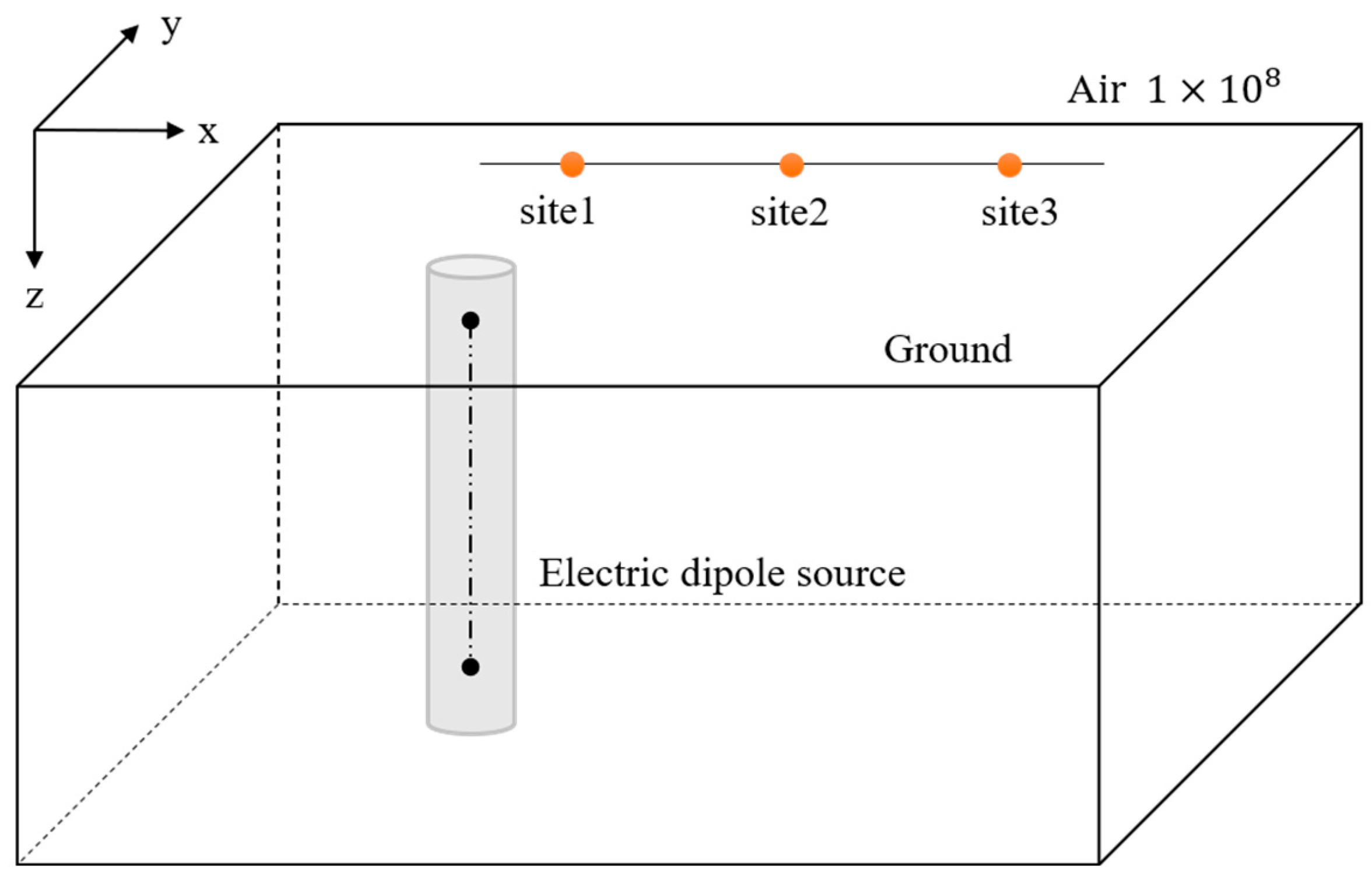



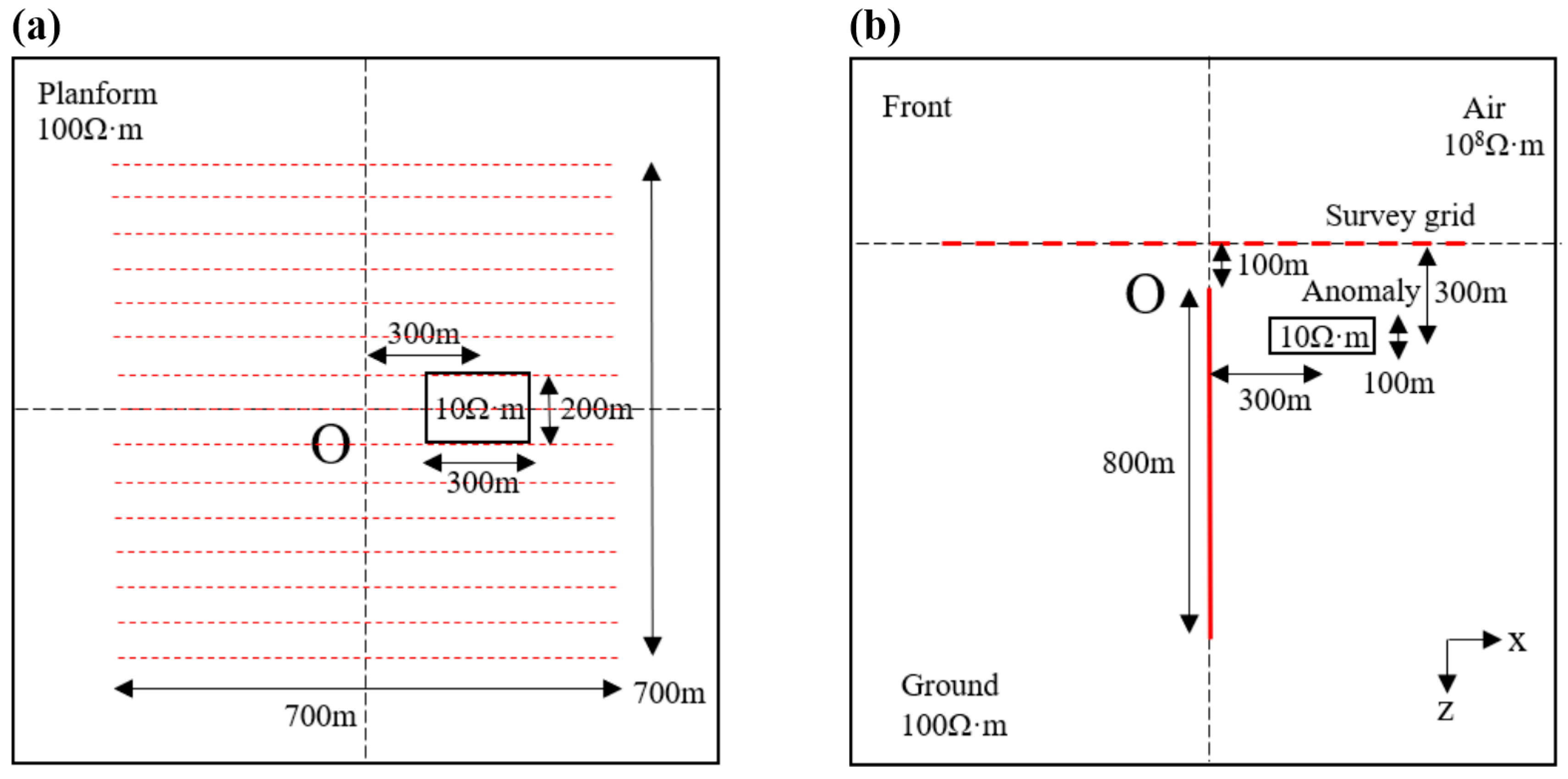



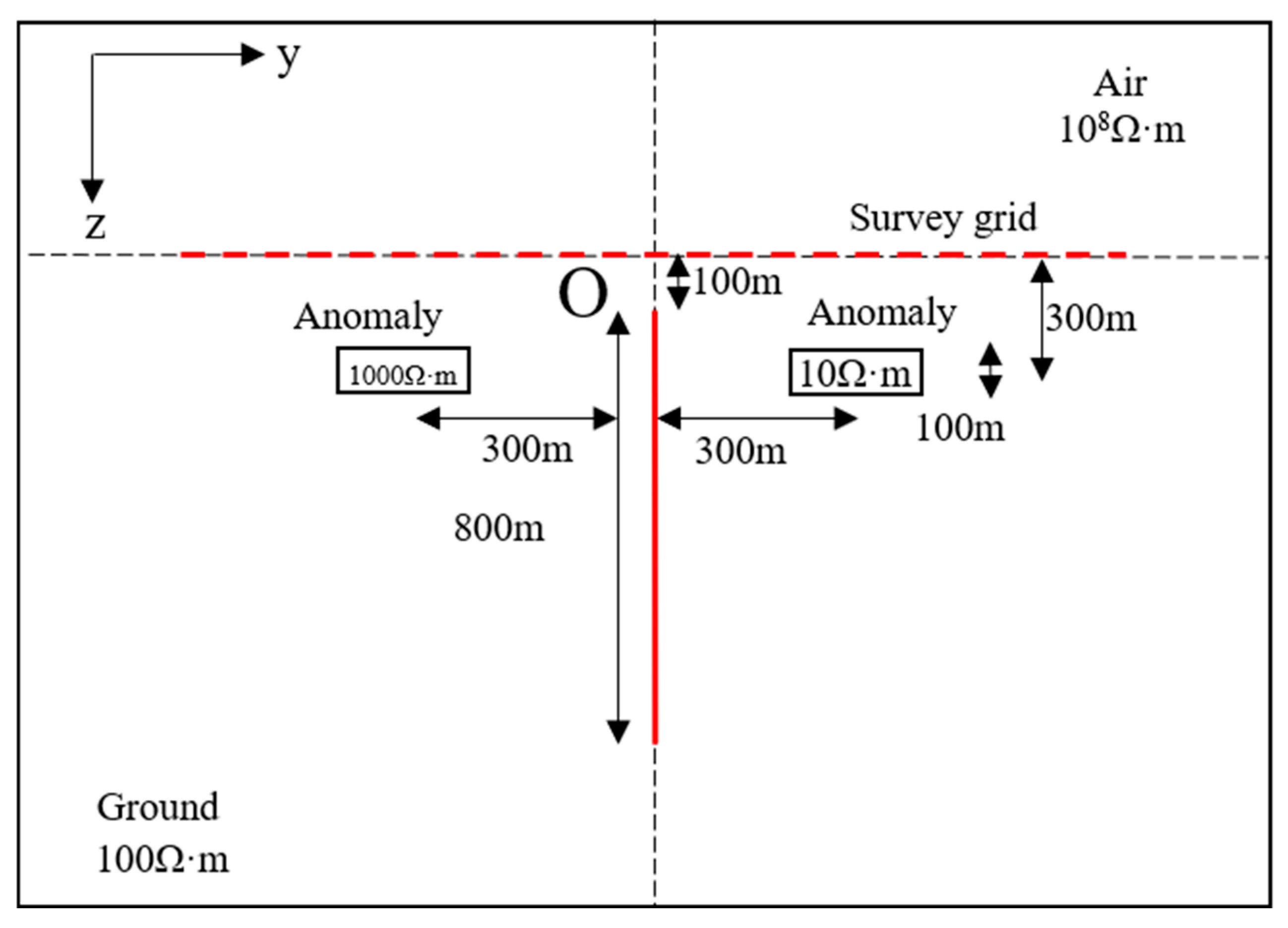
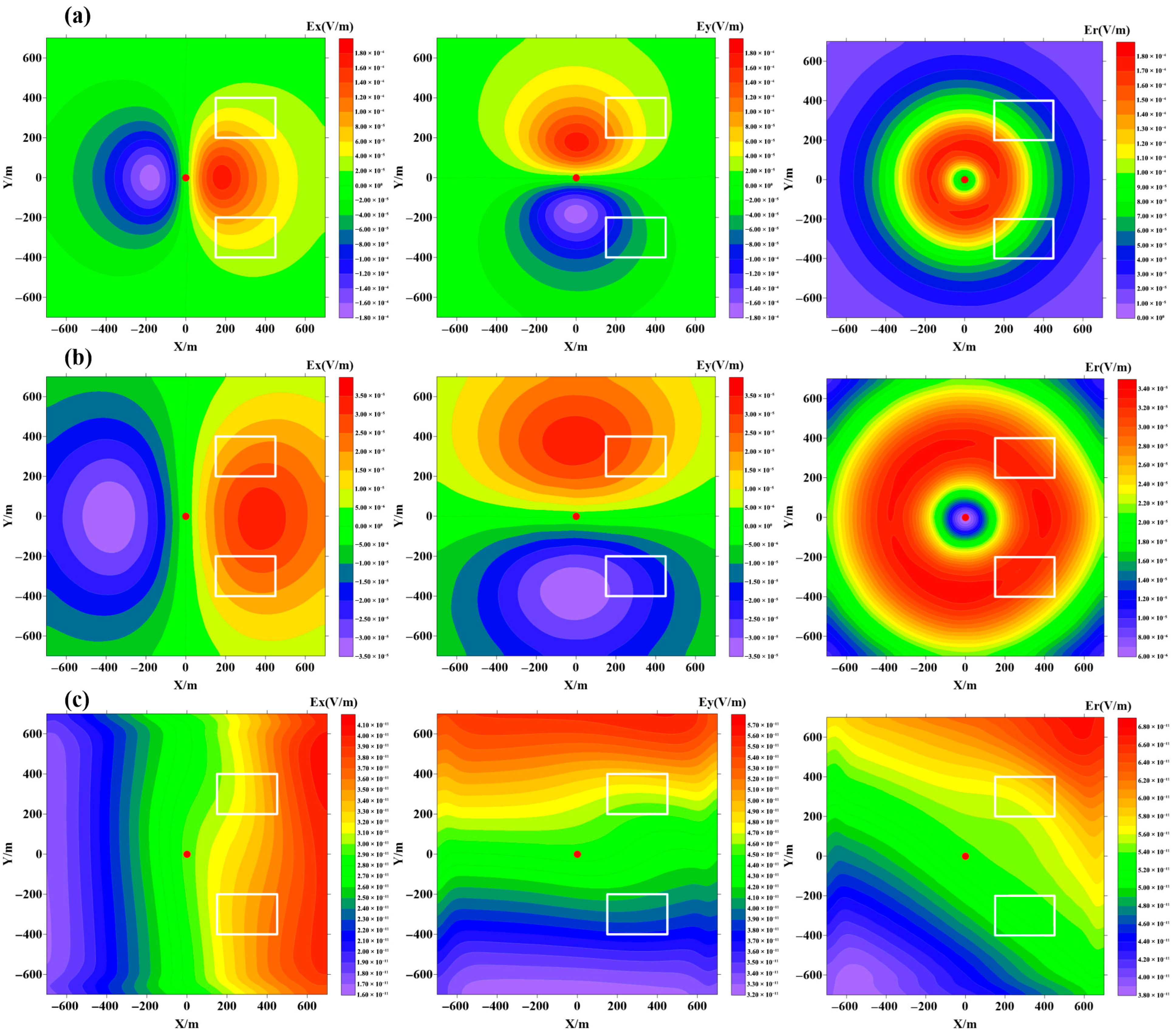


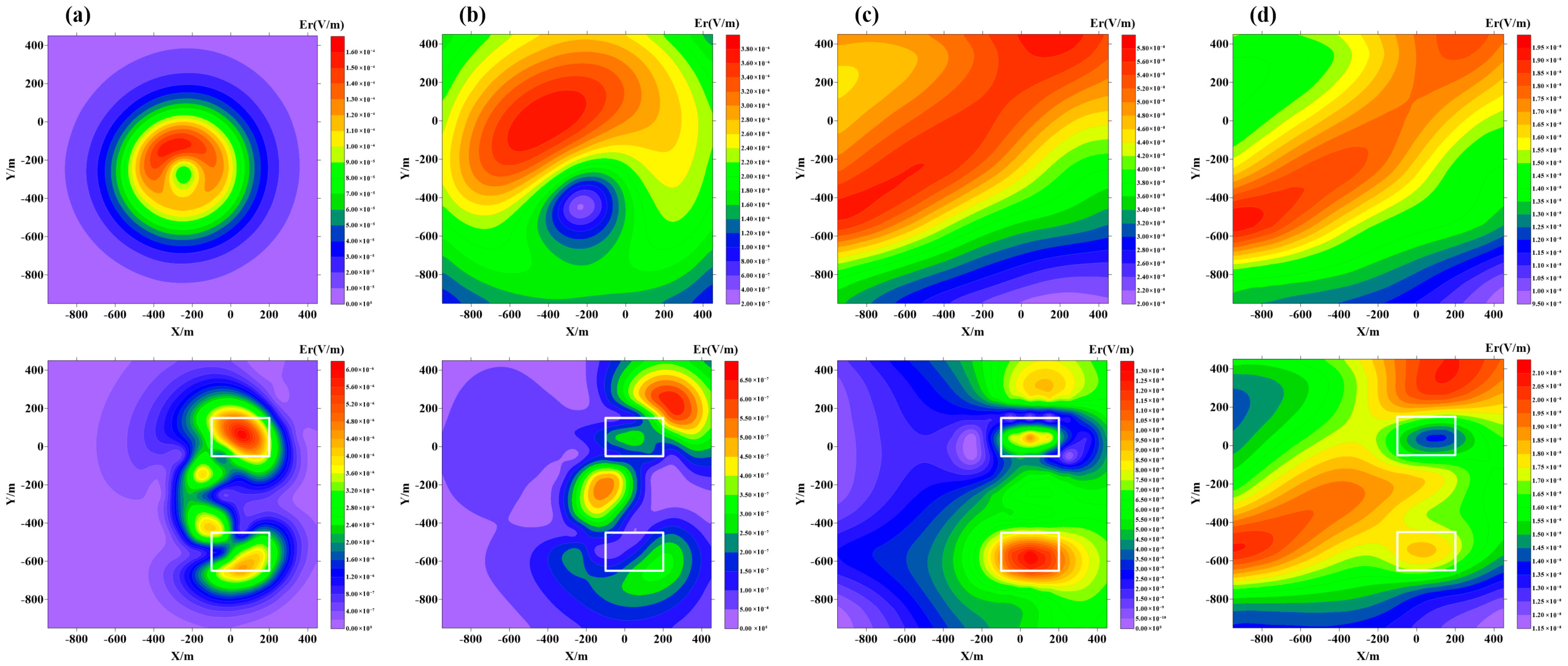


Disclaimer/Publisher’s Note: The statements, opinions and data contained in all publications are solely those of the individual author(s) and contributor(s) and not of MDPI and/or the editor(s). MDPI and/or the editor(s) disclaim responsibility for any injury to people or property resulting from any ideas, methods, instructions or products referred to in the content. |
© 2025 by the authors. Licensee MDPI, Basel, Switzerland. This article is an open access article distributed under the terms and conditions of the Creative Commons Attribution (CC BY) license (https://creativecommons.org/licenses/by/4.0/).
Share and Cite
Liu, J.; Cheng, T.; Zhou, L.; Wang, X.; Xie, X. 3D Forward Simulation of Borehole-Surface Transient Electromagnetic Based on Unstructured Finite Element Method. Minerals 2025, 15, 785. https://doi.org/10.3390/min15080785
Liu J, Cheng T, Zhou L, Wang X, Xie X. 3D Forward Simulation of Borehole-Surface Transient Electromagnetic Based on Unstructured Finite Element Method. Minerals. 2025; 15(8):785. https://doi.org/10.3390/min15080785
Chicago/Turabian StyleLiu, Jiayi, Tianjun Cheng, Lei Zhou, Xinyu Wang, and Xingbing Xie. 2025. "3D Forward Simulation of Borehole-Surface Transient Electromagnetic Based on Unstructured Finite Element Method" Minerals 15, no. 8: 785. https://doi.org/10.3390/min15080785
APA StyleLiu, J., Cheng, T., Zhou, L., Wang, X., & Xie, X. (2025). 3D Forward Simulation of Borehole-Surface Transient Electromagnetic Based on Unstructured Finite Element Method. Minerals, 15(8), 785. https://doi.org/10.3390/min15080785





